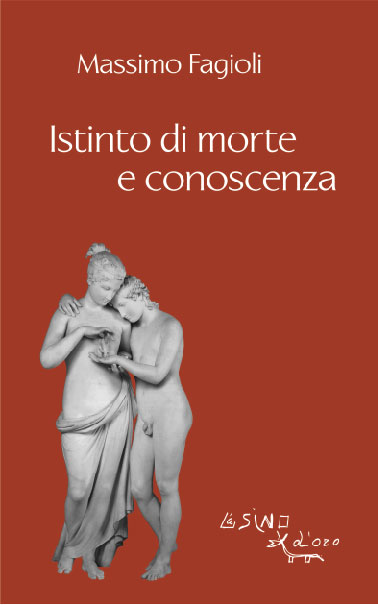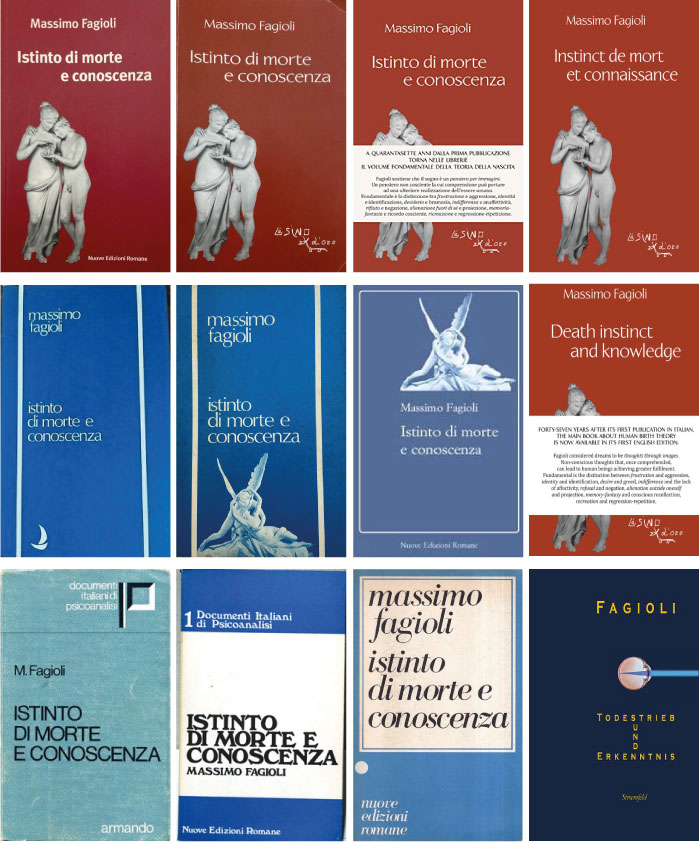Fagioli considered dreams to be thoughts through images. Non-conscious thoughts that, once comprehended, can lead to human beings achieving greater fulfilment. Fundamental is the distinction between frustration and aggression, identity and identification, desire and greed, indifference and the lack of affectivity, refusal and negation, alienation outside oneself and projection, memory-fantasy and conscious recollection, recreation and regression-repetition.
Death instinct and knowledge is the bedrock of Massimo Fagioli’s Human Birth Theory. It was first published in 1972 by Armado Editore. The book’s latest Italian edition was published in 2017, by L’asino d’oro edizioni, with the first English edition becoming available in 2019. Throughout the years, and the several Italian editions, fourteen so far, the contents of the book have never been changed, which testifies the coherence and solidity of the Theory. However, a new image has been chosen for the book’s more recent covers, and new forwards added. In there, the author describes his continuous research and the success of the cure within Analisi collettiva [large group analysis]
On the book’s back cover, one can read, ‘With decades of Analisi collettiva, verbal thought has become richer and more extended. The ‘vision’ of human birth has now been realized with fifteen words that define the non-material reality that has always been said to be unknowable.
Reaction, pulsion, vitality, creation, existence, time, capability to imagine.
Strength, movement, sound, memory, certainty that a breast exists.
Human Birth Theory is the foundation of the psychotherapeutic approach carried out by a large number of psychiatrists, psychologists and psychotherapists and, at the same time, a precious interpretation tool to nurture a new vision of the world and of human beings, in all domains of knowledge, education, politics, science and society, to give rise to new anthropology.

Contents
Death instinct and knowledge, first English edition, 2019, L’Asino d’oro edizioni
The disappearance fantasy
The ‘absence’ of the analyst, 15. The issue of ‘frustration’, 17. The patient’s reaction to the absence of the
analyst, 27. A case history, 31.
The disappearance fantasy and the death instinct
The sadomasochistic relation with the object and the disappearance fantasy against the object, 53. The
death instinct as fantasy, 56. Can the disappearance fantasy be the mnemic trace of the previous stage?, 61. The mnemic trace of the previous stage, 64. The mnemic trace of the intrauterine condition as a libidinal source of desire, 72. The disappearance fantasy as creative realization of the death instinct, 76. The death instinct and knowledge. Development and the race towards death, 83. A reflection on the concept of identification, 88. The newborn’s ‘blindness’ and first relation with the breast. greed, 92. Splitting: the physical object and the psychic object, 94. The death instinct and the realization of a psychic life, 98. ‘No’ and distancing oneself from the object without making the object disappear, 104.
The disappearance fantasy and oral ambivalence. Curiosity and affectivity
At the oedipal level, 117. At the level of the part‐object breast, 121. Ambivalence, 127. Abandonment of desire and the anguish of the loss of affectivity, 137. The difficulty of making patients independent because of their anguish of losing affectivity, 143. A case history, 148. Curiosity and sexuality, 156. Detachment from the physical object and the depressive position by M. klein, 160. The loss of the image of the object and the creation of verbal symbols, 163. A whole object as a full, three‐dimensional object, 167.
The disappearance fantasy and envy
Neonatal ‘blindness’ and the splitting between good and bad, 175. The envious relation with the ‘good’ object, 179. Envy and projective identification, 184. The concept of aggressiveness; ‘death’ in the object‐relation, 190. Envy and the pulsional investment of the object, 194. The impossibility of being like the object, 197. Identification with the envied object, 205. Envy and Idealization, 209. The envious attack against the whole object involving the genital libido, 212. Gratitude and acknowledgment. Depressive dependence on the idealized object and freedom, 215.
Projection and intuition
Negation and Projection, 222. The concept of intuition, 230. The law of equality, 243. Projection as making the object like oneself, 245. Projective identification, projection and the pulsional investment of the object, 250. The analyst’s ‘isolation’ and his or her libidinal dynamic, 265. ‘I can’t’ as a conflicting situation, 273. The analyst’s intuition as a fundamental element for analytic work, 276. The Sphinx, 282. giving a thinker to one’s own thoughts. The recovery of the libido, 283.
The Invisible Violence
287, Forty years later
Rome, march 2010
Foreword to the first edition, 297
Rome, december 1970
Foreword to the second edition, 305
Rome, march 1976
Foreword to the French edition, 315
Rome, july 1979
Foreword to the fifth edition, 329
Rome, may 1980
Editions

Detah instinct and knowledge
Fourteenth edition may 2017
Thirteenth edition april 2010
Twelfth edition april 2007
Eleventh edition april 2005
Tenth edition july 2002
Ninth edition may 2000
Eighth edition june 1996
Seventh edition ocotber 1991
Sihth edition october 1986
Fifth edition july 1980
Fourth edition june 1978
Third edition november1977
Second edition april 1976
First edition january 1972
